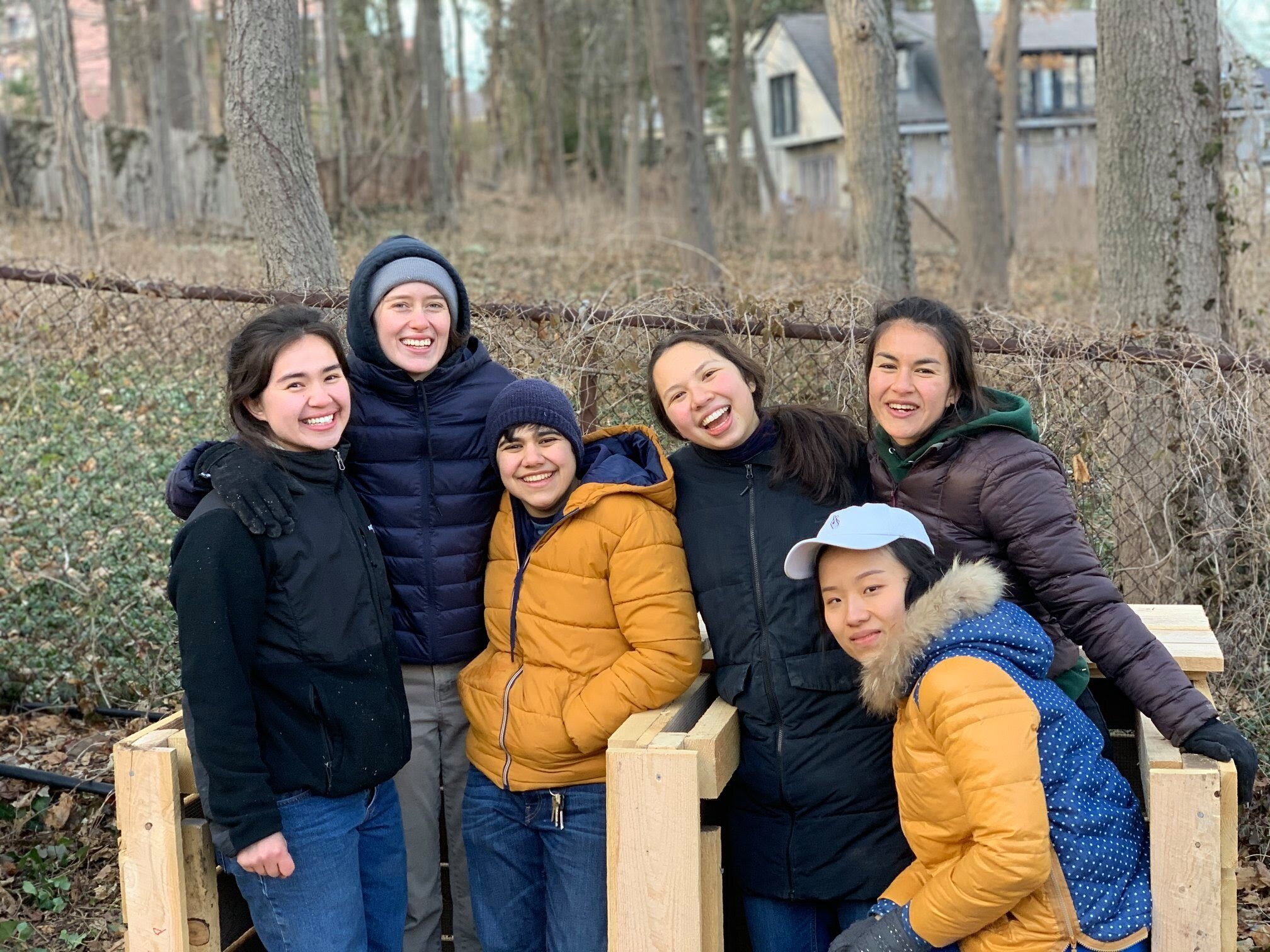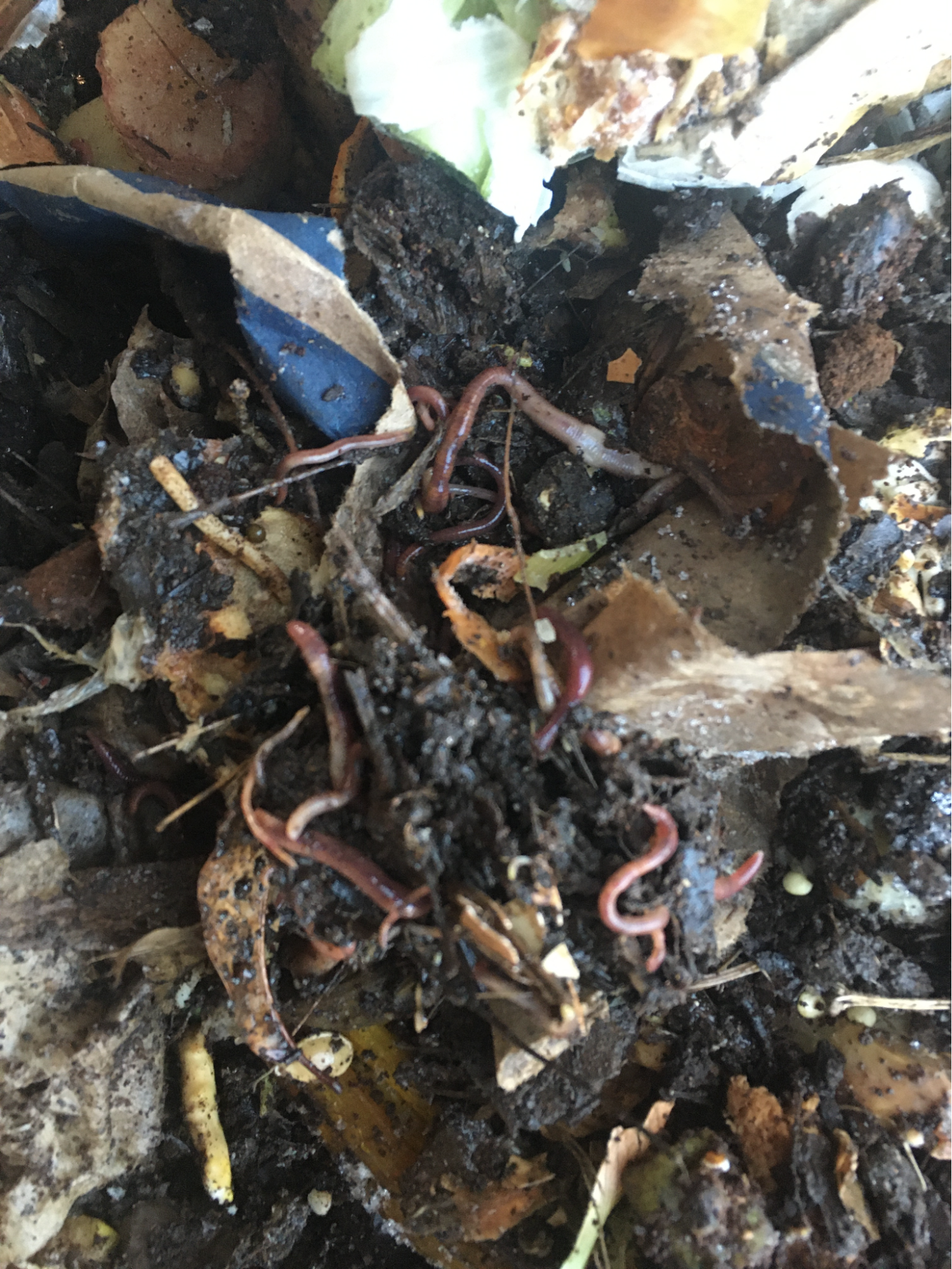Group picture from the 2-bin volunteer build (all done by hand!) in early March 2020. Volunteers are standing in the 2 bin system itself.
The following is a transcript from an interview done in October 2020. “KE” refers to Kayley Estoesta, a YSFP Comms Manager, and “FAL” refers to Forest Abbott-Lum, the YSFP Composter-in-Residence.
The “A-peel” of Compost
KE: How did you become interested in the world of waste management?
FAL: Waste management kind of just happened to me. Around 2016, I started looking for jobs in New York City, where I could use Mandarin, and also get outside. And what came across my radar was the New York City Compost Project, which is funded by the Department of Sanitation. They were hiring for a position with a pretty wild title called “Organics Recovery Coordinator.” It was located in Flushing, Queens, which is America's fastest growing Mandarin-speaking Chinatown. It just seemed like a unicorn of an opportunity, because I would get to be outside managing an industrial compost site, and I'd also get to be doing Mandarin Chinese outreach for the community, and building a zero waste coalition from home gardeners to the people that did Tai Chi in the park.
Forest taking a break from some tractor work at the compost site in Queens (look at that carbon:nitrogen ratio!).
It was really exciting to be on the front lines of getting people to not take trash for granted. And I became totally fascinated by the flow of urban food waste. Waste is an externality that we all have personal contact with to some degree. The biggest slice of the food waste pie is actually household food waste.
Waste management is also a very male dominated space. In general, the community gardening and environmental outreach world is pretty female-dominated. But to generalize, the world of waste management is a bunch of dudes between the ages of 40 and 60, and a really macho work culture with big machines and heavy lifting. And that was such a new cultural space for me to be in. I'd been in the policy world, and then I had been in the world of sustainability startups. The identity of someone who's in waste management sometimes can be completely opposite to the identity of someone who self-identifies as an environmentalist; yet, we're all in the environmental field.
And I can tell you a little bit more about the compost site that we were running in Queens. If we had been in California, it would have technically been large enough to be considered and regulated as an industrial compost site. But as far as industrial compost sites go, it was actually quite small. What we were trying to do was prove that you could make compost in a way that was friendly to urban environments. It doesn't smell bad, it doesn't attract rodents, and it can benefit the community who gardens and participates in it as a green space.
KE: Before we get further, could you briefly explain the process of composting? And speak to why composting as opposed to other methods of waste management?
FAL: Composting is a managed method of controlling the decomposition of organic waste, so that your end product creates a nitrogen rich, organic material that can be used as a type of fertilizer. A lot of people who are backyard composters get really anxious about what they can compost. They're like, “Is the whole pile gonna become contaminated if a little bit of egg white gets in there?” But when you get to the industrial scale, people are composting Diet Dr. Pepper by running over it with a huge machine and crushing out all the liquid, or composting entire dead pig carcasses.
When you’re making industrial-scale compost, things are getting so hot in the pile that you can get to a point called PFRP (process to further reduce pathogens, 15-20 degrees C). The microbial activity is getting so hot, you're killing off all of these harmful pathogens, which is what you have to do to sell compost if you're an industrial compost site. But once you're getting that hot, you can put pretty much anything organic in there. Meat, dairy, compostable bags made of bio plastic, shredded dollar bills.
Forest waving from the deck of an industrial compost sifter in California while getting trained as a US Composting Council Site Operator.
The Issue of Household Food Waste
KE: Could you expand on your earlier point about urban food waste being the bulk of all waste?
FAL: 40% of total food waste in America is generated in the process of getting food from a farm all the way to someone’s fork. Of that 40%, how much do you think is generated from individual households? It's 43%. So it's not the majority, but it's the biggest slice of the pie by far. What’s more is that household food waste is eight times more carbon intensive than upstream food waste just because of the refrigeration and preparation it took to get to your fridge.
Composting is not a perfect solution to this issue. The best case scenario for reducing food waste is just having people eat the food. Second best is that animals are eating the food. Third best, and this is contested, is power generation through a biogas digester. And then in fourth place is compost, but the EPA considers compost just a little bit above landfill or incineration.
I wanted to address briefly what happens to food waste if it goes to the landfill. And of course, this really varies by where you are. If you're here in Connecticut, my understanding is most of your trash is getting incinerated. But if it's going to landfill, the food waste problem also becomes an environmental justice problem. Because oftentimes, landfills are located next to communities of color. And then you have just a bunch of volatile organic compounds and potential health risks. Some of the earliest environmental justice work by the Black community was protesting the building of a landfill. There's a long history between environmental justice and landfill organic waste. You have to think if it’s not going to the compost site, where is it going? And chances are to the landfill or the incinerator.
But I think the really tricky thing about household food waste reduction in the United States is that this is a dispersed collective action problem that happens out of the eye, making it harder to implement mass behavior change.
KE: How much do you see this problem of food waste being at the scale of the individual and the individual's behavior, versus at the scale of the local/city government level, versus national policy?
FAL: Food waste does vary from place to place. If you're in the Global North, most of your food waste is consumer driven at the household level. And if you're in the Global South, most of your food waste is driven by supply chain losses. I'm just going to zero in on the United States.
I think there are so many well-intentioned food waste bloggers that are trying to teach you how to cook with your banana peels. And I applaud their effort. But I think that approach is a bit misguided.
What has worked in other parts of the world, South Korea being a good example, is when you make the private public. In parts of Seoul, they installed food waste counter machines, where you have to separate out your food waste, and then bring them to a publicly viewable area where it runs up a fee for how much food waste you're generating. That's actually seen a 95% decrease in household food waste.
With my experience in New York City, which is a fairly liberal city, I don't know if Americans would go for that approach. The challenging thing about the United States is that for so long, we have really normalized the idea that trash is something that you only need to think about for like 0.3 seconds. Changing the narrative on that is not impossible, but it is difficult. Part of what we were doing for the compost project was to set up a food scrap drop off station. We would set up buckets to collect compostables voluntarily from New York City residents. And while people were commuting to the subway, we would place them out and have outreach materials. We were essentially public-facing representatives of compost on behalf of the Department of Sanitation.
Another important thing is changing the material circumstances of how people buy groceries. On the grocery store level, this means selling unbundled produce, and making sure that when you buy a pack of herbs you can take what you want from it. I have a bunch of rotting herbs in my fridge right now, don't y'all? So changing the material circumstances and portion sizes in which people consume food are your best strategies for reducing household food waste.
Making Compost Cute! : Compost at the YSFP
Food scrap + carbon mix at the Yale farm with some really healthy looking red wiggler worms!
KE: Could you tell us about the new compost system that you helped build for the YSFP last spring?
FAL: The idea was that we would create a system that would be rodent proof and allow us to compost a wider range of waste. What that entails is making sure your bins are sealed off so you don't have rodents getting in, because that is the worst case scenario for any community compost site. Number two priority is to actually compost the range of waste that is produced on the farm, especially the aromatic food waste that hadn’t been composted before. To do this you need a sealed off compost bin and a good mix of browns, which are carbonaceous materials needed in order to get your compost pile hot enough to kill off a lot of the pathogens. That’s 131 degrees or above for three consecutive days.
One benefit is that when you build a really nice looking compost system involving the community, it visually centers it as an important part of the farm in a way that a decomposing pile of organic material does not. Making things cute is actually very vital.
After a colleague, Jenna Davis, helped me get the lumber, I partnered with my friend Jon Miller. He is running a business that helps veterans with job placement (Outlaws Inc.) and he wanted a test run for mentorship and to build something with his hands. By winter we were able to build a three-bin system.
Jon with the first three-bin at the Yale Farm.
After this pilot, we had some extra lumber; coordinating with Jacquie and Jeremy, our next idea was to do a public-facing workshop. We had about 10 people from the Forestry School and YSFP come out to help us build a two-bin system, which is going to be dedicated to in-person events at the Farm when they resume, so you can just walk right beyond the pizza oven and then drop off your compostables.
It was my first time actually building a compost bin. And big shout out to Jon, for being my main mentor and showing me how to actually put it together. But I came in with the plan and the blueprints and a compost site from the New York City compost project. And that is open source. So if anyone ever wants to build their own, I have the blueprint ready for them. It just takes a day and two people. YSFP funded the materials, they were super supportive in getting it all together.
KE: Thanks so much for your time and for sharing all this knowledge, Forest. I can’t wait to see our compost in action back at the Farm!





